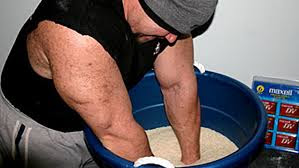If this isn't the best title for a blog piece on grip strengthening this year then I'll give it all up. I actually don't have much more than the title actually. Sorry. I've spent most of the morning thinking about how I help patients regain hand strength. What special tools do I utilise and what is the science behind these unique methods? Sorry again. I've got nothing for you beyond gut although I'm sure there is some science out there.
When we talk grip strength, much of the conversation is based around differentiating between power grip and precision grip. Both types then get torn up into even more specifics. Power grip has 4 forms apparently. There's cylindrical grasp, ball grasp, hook grip and lateral prehension (thumb adduction). Pinch also has 4 forms, precision, oppositional, key pinch and chuck grip (1,2). So when I get a patient referred for rehab with the suggestion that "maybe a stress ball would help", it's hard not to feel a little superior.

My current favourite is the rice bath. It encourages composite wrist and hand movement, it facilitates all grip and pinch types, and there's a sensory component to it as well which may assist with proprioceptive feedback. The key is variation regardless of what you prefer. Use a ball, but also use a rope, or encourage wringing of a wet towel. Isometric holds of a barbell will build hook grip strength, but hanging from a chin up bar will encourage cylindrical grip. Remember that there is a clear correlation between grip strength and shoulder stability(3). Work in pronation and supination, sitting and standing, shoulder abduction and flexion.
So, no science, but some sense. Have a look at how your patient grips. Use a rolled up bandage instead of a ball. Use a pillow or a handle. Empty 5 kilos of rice into a bucket. Look at what's not working, at what they need to do, and go from there. "Isos in iso", brilliant. Should have been in advertising!
Look after those fingers,
Hamish
(1) Duncan S. et al. Biomechanics of the Hand, Hand Clinics 29 (2013) 483-92
(2) Landsmeer J. Power Grip and Precision Handling, Ann Rheum Dis 21 (1962) 164 (3) Horsley I. Do changes in hand grip strength correlate with rotator cuff function? Shoulder Elbow 8-2 (2016) 124-9



